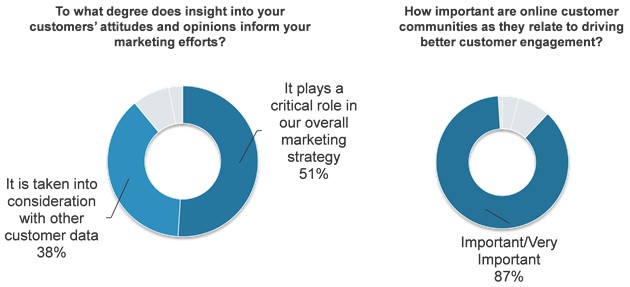In today's hyper-connected world, shoppers are using all channels—mobile, digital, social, physical—to interact with brands throughout the purchase journey, but marketers are having trouble connecting with customers at the right time in the right channel.
Fully 50% of companies are struggling with this issue and with understanding their customers, recent research from Forrester finds. Forrester cited key challenges, including lack of information about new buyers and an inability to make use of customer data effectively.
To address those barriers, marketers can tap into the full potential of community marketing to engage with users during the shopping lifecycle and ensure a seamless experience.
Online communities offer multiple ways for consumers to engage with each other and the brand with discussion boards, Q&A sessions, and other resources. However, according to Forrester, this channel is one of the last methods used to gather customer data:

Base: 279 marketing and e-commerce professionals involved with online marketing strategies
in NA, EMEA, APAC & LATAM
Source: A commissioned study conducted by Forrester Consulting on behalf of SAP,
August 2016
Information from online communities' results in an open dialogue that can be mined for consumer insights and feedback. In fact, Forrester also found, 87% of companies consider customer community marketing to be important for driving better customer engagements. Communities can also be used to host user-generated content, which can be influential for consumers throughout their purchase journey.
This data derived from online communities can be used to do more than improve the customer experience; it can also be analyzed to drive marketing decisions and foster ongoing customer loyalty.
To capitalize on the true value of community marketing strategy, marketing teams should...
1. Offer consistent content
User-generated content is becoming increasingly important, because consumers are more likely to consider third party or peer reviews when making a purchasing decision. When shoppers have the option to look at user reviews, questions from their peers, and responses from the brand, they can select the right solution based on others' recommendations and experiences. The result is a positive online customer journey, which increases the likelihood that shoppers will return to the brand for new products or validate their purchase by writing a review.
User-generated content provides an opportunity for brands to better understand consumers' responses to their offerings. Based on this understanding, to ensure a seamless experience, brands should tightly integrate content among all consumer-facing channels, assets, and efforts—including communities, marketing, product catalogs, and commerce sites. That consistency of information will enable the shopper to make informed decisions.
Forrester also found that 59% of companies say customers are using community-generated content when making purchases, and 75% agree that those who make use of community-generated content are more likely to make a purchase than those who don't. Moreover, 77% of marketers agree that community-generated content accelerates buying decisions.
2. Use customer data to inform marketing strategy, decisions, and goals
According to Forrester, 89% of companies say customer data plays an important role in their marketing strategy and 51% say it's a critical role. Data from online communities can be added into the funnel of information used by marketers to develop their tactics. User-generated content from the community is especially valuable to brands, which can then use consumer feedback to tweak products or brainstorm new solutions that align with customer needs.

Base: 279 marketing and e-commerce professionals involved with online marketing strategies in NA, EMEA, APAC & LATAM
Source: A commissioned study conducted by Forrester Consulting on behalf of SAP, August 2016
3. Integrate a community marketing strategy earlier into the digital customer journey
Communities should be a living resource that are continually updated by users and brands with new information, questions, pictures, and other forms of content. The platform should be an ongoing opportunity for the customer to engage with the brand to share stories, discuss challenges, and explore new products. Based on these types of content, the community can be used by consumers at the beginning of their search or following their purchase to ask additional questions, write a recommendation, or work with their peers to brainstorm additional uses. Communities offer continual touchpoints that benefit consumers with enriched content. The platform can also reduce online dropout and open lines of communications with prospects and customers.
Community marketing offers marketers on opportunity to better understand their customers by capitalizing on the data those consumers provide online. The living platform should have enough user-generated and branded content to help shoppers in the beginning, middle, or end of their journey. Marketers can glean this data to offer personalized content at any point in the journey on the channel of their choice—whether on social media or in the community.
More Resources on Community Marketing
The Case for Community-Based Marketing in 2021
Move Over, Social Platforms: Niche Online Communities Are the Wave of the Future
Keep Consumers From Cheating on You: Foster a Community to Stay Together




